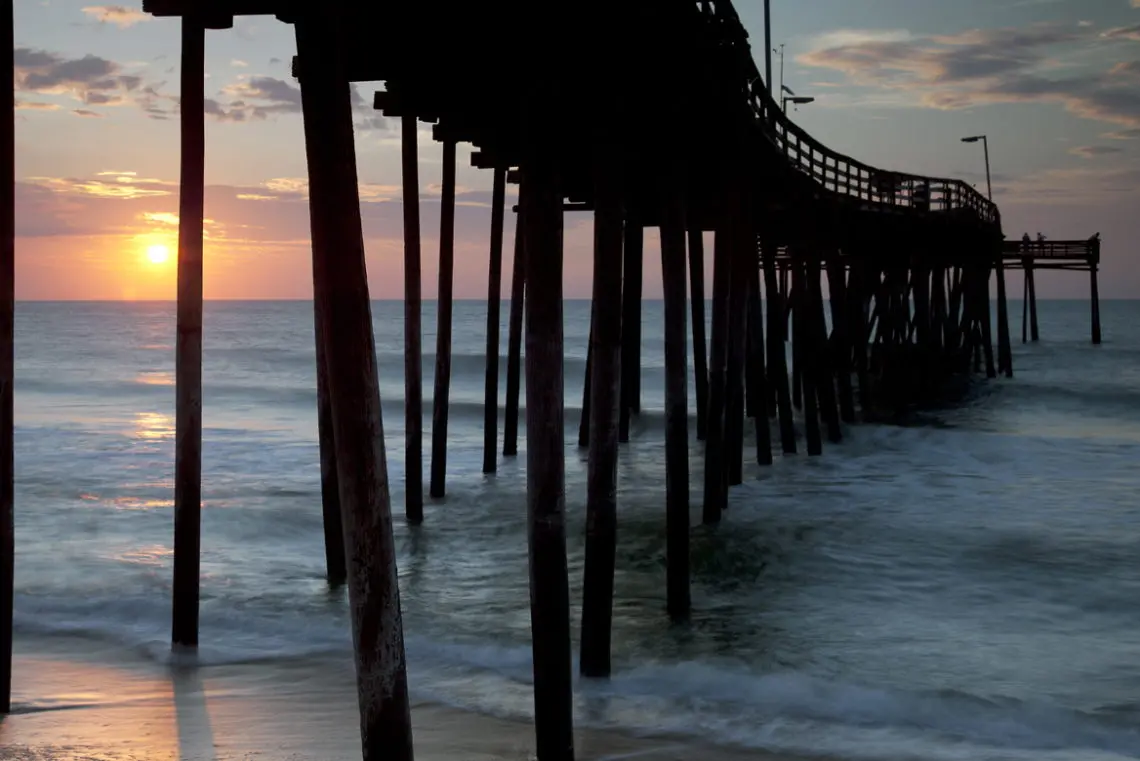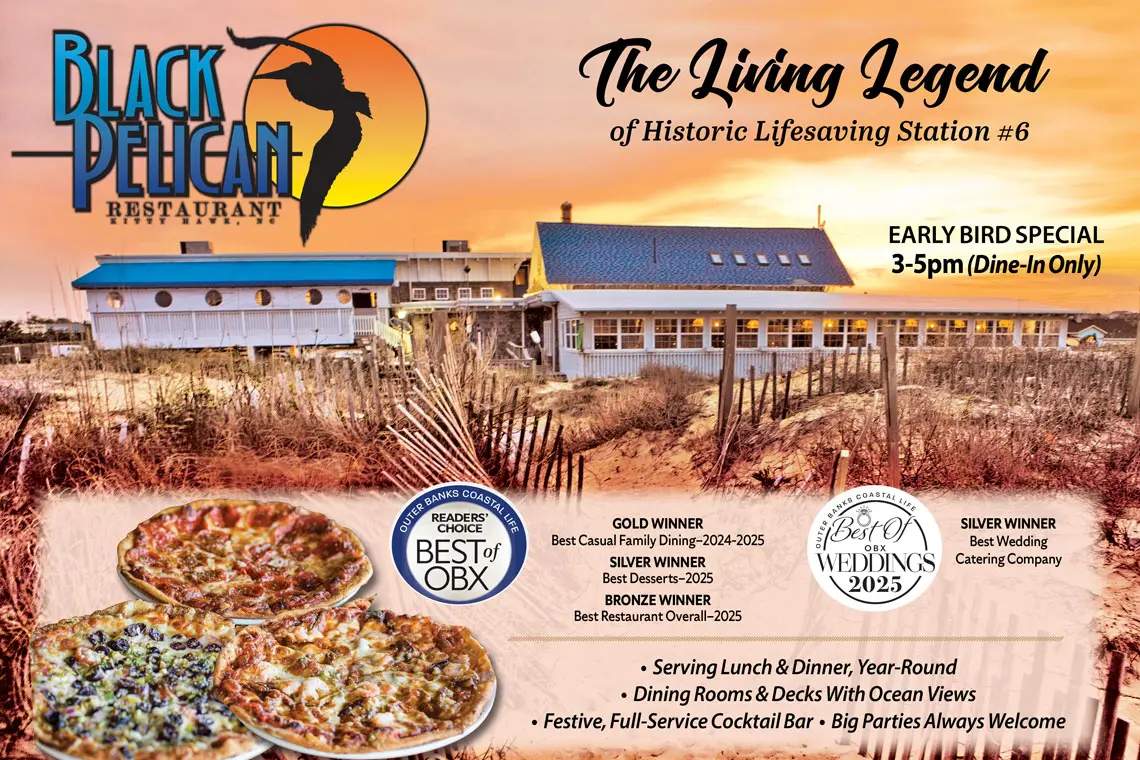The image is one of the most haunting in American folklore: Eleanor Dare cradling her infant daughter as they struggle through a vast wilderness, seemingly forgotten by her father who brought them to an unfamiliar land, then left them to fend for themselves.
In the four centuries since their disappearance, Eleanor and Virginia Dare have become true American heroines, players in an epic unsolved mystery that still challenges historians and archaeologists as one of America's oldest. In 1587, over 100 men, women and children journeyed from England to Roanoke Island on North Carolina's coast and established the first English settlement in America. Within three years, they had vanished with scarcely a trace. England's initial attempt at colonization of the New World was a disaster, and one of America's most enduring legends was born.
The lie of the land of modern Roanoke Island appears much as it did at the time of the colonists' arrival. The low, narrow island lies between the treacherous Outer Banks and the mainland. Although it is influenced by the Atlantic Ocean, it is a verdant oasis compared to the harsh winds and pounding surf of the barrier islands. Instead, Roanoke is characterized by thick marshlands and stands of live oaks teeming with wildlife--a much more hospitable site for settlement.
In 1584, explorers Philip Amadas and Arthur Barlowe were the first to set eyes on the island. They had been sent to the area by Sir Walter Raleigh with the mission of scouting the broad sounds and estuaries in search of an ideal location for settlement. Amadas and Barlowe wrote glowing reports of Roanoke Island, and when they returned to England a year later with two Natives, Manteo and Wanchese, all of England was abuzz with talk of the New World's wonders.
Queen Elizabeth herself was impressed, and she granted Raleigh a patent to all the lands he could occupy. She named the new land "Virginia", in honor of the Virgin Queen, and the next year, Raleigh sent a party of 100 soldiers, craftsmen and scholars to Roanoke Island.
Under the direction of Ralph Lane, the garrison was doomed from the beginning. They arrived too late in the season for planting, and supplies were dwindling rapidly. To make matters worse, Lane, a military captain, alienated the neighboring Roanoke Indians, and ultimately sealed his own fate by murdering their chief, Wingina over a stolen cup.
By 1586, when Sir Francis Drake stopped at Roanoke after a plundering expedition, Lane and his men had had enough. They abandoned the settlement and left behind a fort, the remains of which can still be seen at Fort Raleigh National Historic Site today. Ironically, a supply ship from England arrived at Roanoke less than a week later . Finding the island deserted, the leader left behind 15 of his men to hold the fort and returned to England for reinforcements.
Raleigh was angry with Lane but not deterred from his mission. He recruited 117 men, women and children for a more permanent settlement, and appointed John White governor of the new "Cittie of Raleigh". Among the colonists were White's pregnant daughter, Eleanor Dare, his son-in-law Annanias Dare, and the Indian chief Manteo, who had become an ally during his stay in England.
Raleigh had since decided that the Chesapeake Bay area was a better site for settlement, and he hired Simon Fernandes, a Portuguese pilot familiar with the area, to transport the colonists there. Fernandes, however, was by trade a privateer in the escalating war between Spain and England. By the time the caravan arrived at Roanoke Island in July, 1587, to check on the 15 men left behind a year earlier, he had grown impatient with White and anxious to resume the hunt for Spanish shipping. He ordered the colonists ashore on Roanoke Island.
The colonists soon learned that Indians had murdered the 15 men and were uneasy at the prospect of remaining on Roanoke Island. But Fernandes left them no choice. They unloaded their belonging and supplies and repaired Lane's fort. On August 18, 1587, Eleanor Dare gave birth to a daughter she named Virginia, thus earning the distinction of being the first English child born on American soil. Ten days later, Ferndades departed for England, taking along an anxious John White, who hesitantly decided to return to England for supplies. It was the last time he would ever see his family.
Upon his arrival in England, White found himself trapped by the impending invasion of the Spanish Armada. Finally, two years after the stunning defeat of the Armada, he again departed for Roanoke Island. He arrived on August 18, 1590--his grand daughter's third birthday--and found the Cittie of Raleigh deserted, plundered, and surrounded "with a high pallisado of great trees, with cortynes and flankers, very fort-like". On one of the palisades, he found the single word "CROATOAN" carved into the surface, and the letters "CRO" carved into a nearby tree.
White knew the carvings were "to signifie the place, where I should find the planters seated, according to a secret token agreed upon betweene them and me at my last departure from them...for at my coming away, they were prepared to remove 50 miles into the maine". He had also instructed the colonists that, should they be forced to leave the island under duress, they should carve a Maltese cross above their destination. White found no such sign, and he had every hope that he would locate the colony and his family at Croatoan, the home of Chief Manteo's people south of Roanoke on present-day Hatteras Island.
Before he could make further exploration, however, a great hurricane arose, damaging his ships and forcing him back to England. Despite repeated attempts, he was never again able to raise the funding and resources to make the trip to America again. Raleigh had given up hope of settlement, and White died many years later on one of Raleigh's estates, ignorant to the fate of his family and the colony.
The 117 pioneers of Roanoke Island had vanished into the great wilderness.
In the following years, evidence as to their fate was slow to emerge, but some intriguing accounts exist. In 1709, English explorer John Lawson visited Roanoke Island and spent some time among the Hatteras Indians, descendants of the Croatoan tribe. In A New Voyage to Carolina, he wrote "that several of their ancestors were white people and could talk in a book as we do, the truth of which is confirmed by gray eyes being found infrequently among these Indians and no others."
In the 1880s, with the approach of the Roanoke Colony's 300th anniversary, a North Carolina man named Hamilton MacMillan proposed a theory that holds some credence today. MacMillan lived in Robeson County in southeastern North Carolina near a settlement of Pembroke Indians, many of whom claimed that their ancestors came from "Roanoke in Virginia".
According to MacMillan, the Pembrokes spoke pure Anglo-Saxon English and bore the last names of many of the lost colonists. Furthermore, "Roanoke in Virginia" was how Raleigh and his contemporaries referred to Roanoke Island. The Pembrokes also had European features: fair eyes, light hair, and an Anglo bone structure. MacMillan's findings, published in 1888 pamphlet, gained a great deal of attention from the academic community and renewed interest in the Lost Colony
Other less plausible theories and some outright trickery surfaced in the mid-1900s. A series of mysterious rocks first uncovered in 1937 in eastern North Carolina seemed to solve the mystery. The original stone, dubbed the Eleanor Dare Stone, was found in a swamp 60 miles west of Roanoke Island by a traveler. It was covered with strange carvings, which, when deciphered, appeared to be a message from Eleanor Dare to her father, indicating that the colony had fled Roanoke Island after Indian attack.
Over the next three years, nearly 40 similar stones were unearthed from North Carolina to Georgia, and when pieced together, related a fantastic tale of the colonists' overland journey through the southeast, culminating in the death of Eleanor Dare in 1599. Although the academic world was skeptical, the media had a field day and were forced to eat their words in 1940 when an investigative reporter exposed the entire saga as an elaborate hoax.
In the past 40 years, scholars have discovered previously unknown records in the Spanish and British archives that may point the way toward a logical, if not provable, solution. Many historians now believe that after White's departure from Roanoke in 1587, the colony split into two factions, and the largest segment of the colony departed for the Chesapeake Bay, their original destination. Lane had explored the Bay area in 1585, and the colonists probably had maps made by White himself.
When John Smith and the Jamestown colonists arrived in 1607, Smith took up the search for the colonists and discovered that they probably had been in the area. In his dealings with the hostile Indian chief Powhatan, he learned that the colonists had lived among the friendly Chesapeake Indians on the south side of the Bay. Threatened by the intrusion of white men into the region, Powhatan claimed to have attacked the colonists and murdered most of them. As proof of his claim, he showed Smith "a musket barrell and a brass mortar, and certain pieces of iron that had been theirs."
By 1612, the Jamestown leaders had received numerous reports that at least some of the Roanoke colonists were living nearby. They sent out several search parties, but had no success, and soon gave up the search.
What became of the remainder of the colonists left on Roanoke Island? Scholars speculate that they were left behind to meet White upon his return from England, but soon fled to Croatoan, leaving the mysterious carvings behind as a signal to White. Spanish archives reveal that they were gone by June, 1588, when a raiding party put in at Roanoke Island only to find the settlement deserted. Scholars assume that they were then assimilated into the Croatoan tribe.
Today, the north end of Roanoke Island is regularly visited by historians and archaeologists hoping to uncover new evidence as to the fate of the colony. So far, none has been forthcoming. The post and the tree bearing the carvings have long since vanished, although many of the live oaks in the National Historic Site were seedlings during the colonists tenure. No archaeological clues as to the whereabouts of the Cittie of Raleigh have ever been uncovered, and the 500-acre park remains mostly an enigma, apropos to the events that unfolded here 400 years ago.
Most visitors to the Outer Banks are there for the white sandy beaches, towering lighthouses, and shifting sand dunes. The last thing they expect to find is a traditional English flower garden.
But on Roanoke Island, that is exactly what awaits them. Nestled among the trees at Fort Raleigh National Historic Site on the north end of the island, the Elizabethan Gardens are a special place of peace and natural beauty amidst the crush of the tourist-laden beach resorts less than ten miles away. And although the Gardens are becoming a major draw for Roanoke Island (visitors from all 50 states and 44 foreign countries have signed the guest book), they remain, for now, somewhat of a secret.
The colorful serene Gardens are home to hundreds of species of wildflowers, trees, herbs, and shrubs, as well as a substantial collection of valuable antique garden ornaments and ancient statuary, all to please the senses year-round. Masses of blooming rhododendron, tulips, azaleas and dogwoods peak in late April. Magnolias, lilies, and hydrangeas reach bloom in late July. And marigolds, impatiens, and hibiscus provide brilliant autumn color. Even a rare Outer Banks snowstorm transforms the Gardens into a winter fantasy.
The Gardens were created with one purpose in mind: to honor the Elizabethan heritage of Roanoke Island and North Carolina. The Gardens are a memorial to Sir Walter Raleigh's legendary Lost Colony
of 1587, which settled, lived, and vanished on the very site where the Gardens now stand.
In 1950, the Garden Club of North Carolina first proposed the project as a modest two-acre traditional English flower garden costing $10,000. The club leased a tract of land from the Roanoke Island Historical Association, which then owned the site on the island's north end where the colonists lived.
From that point forward, the Garden project took on a life of its own. A Georgia aristocrat named Hay Whitney caught wind of the project and in 1953 donated $100,000 worth of ancient Italian statuary from his estate to the Garden Club. Included were a stunning fountain and pool, a set of four statues modeled after Roman gods and goddesses, a porphyry marble well head, and several other historically valuable pieces.
The Garden Club immediately scrapped the original two-acre plan and embarked on an ambitious fundraising project to fund a $250,000 Garden plan that covered ten acres. The Gardens were completed in 1956 and were immediately hailed as one of the most beautiful gardens in the country. True to their mission, the Garden Club dedicated them to the colonists.
"Down the centuries English women have built gardens to the glory of God, the beauty of countryside and the comfort of their souls," reads the dedication plaque at the Gardens entrance. "The women of the Garden Club of North Carolina, Inc., have planted this garden in memory of the valiant men and women who founded the first English colony in America."
The Gardens complex is actually comprised of four major garden areas connected by landscaped pathways. Visitors are greeted at the Gate House, a gabled structure modeled after a 16th-century orangery and furnished with period antiques. An adjacent courtyard features as its centerpiece a white marble Italian fountain bordered by formal parterres of seasonal flowers. Shakespeare's Herb Garden features a number of medicinal, odorous and culinary plants, including 24 herbs that the Bard used in his plays.
From there, lush paths lined with azaleas, dogwoods, bulbs and spring annuals meander beneath wax myrtles and stately live oaks (some of which were seedlings during the colonists' tenure on Roanoke). Tasteful directional signs point visitors towards hidden alcoves and private spots throughout the grounds.
For example, around one bend lies the stunning Queen's Rose Garden. The walled garden is laid out in a checkerboard pattern of paved walkways lined with period ornaments. Summer is exceptionally beautiful when the grandiflora, floribunda, hybrid tea and climbing roses fill the air with an amazing fragrance.
The formal symmetry of the rose garden is in direct contrast to the Woodland and Wildlife Garden, which preserves the natural environment. The Overlook Terrace is an open grassy vale bordered by Roanoke Sound and has served as t a breathtaking backdrop for hundreds of weddings.
The inspiration for the Gardens, however, is the spectacular 100 square-foot Sunken Garden. Encircled by an 11-foot allee of native yaupon, the garden's focal point ids Hay's donated Italian fountain, pool and balustrade. Eight parterres planted with flowers that bloom during three seasons surround the fountain in formal English style. Statues of mythological figures stand watch of the garden.
Just north of the Sunken Garden is the Gazebo, a 16th-century reproduction thatched with English reed and commanding a spectacular view of Roanoke Sound. It is a quiet nook where visitors can contemplate the fate of the Lost Colony.
Or they may consider the same subject at the statue of Virginia Dare, nestled in a verdant azalea-lined alcove. The first English child born in America, Virginia was a member of the fated colony that disappeared in to the wilderness.
The story behind her statue is just as fascinating. Crafted by an expatriated American sculptor named Maria Louisa Ander in the 1850s, the figure's history spans nearly 100 years and half the globe. Ander created the figure in Rome, then shipped it to America for exhibition. But it the ship sank in a storm off Spain, and the statue remained on the sea floor for two years until salvers finally raised it and sent it on to Boston for sale.
A New York collector purchased it and had it removed to his New York studio. But the studio soon thereafter burned to the grounds, killing the collector. The estate refused to make good on the payment for Virginia, and it reverted to Ander's possession. Desperate to have the work placed where it would be appreciated, she willed it to the State of North Carolina, and upon her death in 1926, Virginia traveled to Raleigh, where she was placed on exhibit in the Hall of History.
However, it soon became the subject of controversy, as Virginia was clad only in a fishnet. After fielding numerous complaints, the Hall of History packed Virginia up and put her in the basement where she remained for several years until a state official found her and put her back on display.
After Paul Green penned The Lost Colony
in 1935, state officials donated the statue to him, and it remained in his possession until 1951. That year, he donated it to the Garden Club for placement in the Gardens. And so, after nearly 100 years after her creation-and 350 years after her subject's birth-Virginia came home to Roanoke Island.
A local legend persists that Virginia grew up among the local Indians and that her spirit roams Roanoke Island in the form of a The White Doe
. One visit to the tranquil Elizabethan Gardens will convince you that, at the very least, her memory is alive and well.
In 1862, when word of the Union's victory over the Confederate forces at Roanoke Island began to spread to the interior of the state, thousands of refugee and runaway slaves flocked to the island. General Ambrose Burnside, touched by the hard-working attitude of the former slaves, created a Freedman's Colony on the island.
For four short years, during and after the war, Roanoke Island, site of the first English settlement in the New World, became the site of the largest settlement of freed slaves in the south. Nearly 300 homes, schools, and businesses sprung up near the center of the island. By 1863, when Lincoln issued the Emancipation Proclamation, the population of the colony swelled to nearly 3,000. In June, 1863, the Union commander mustered the first black regiment of Union troops and transferred them to South Carolina for active duty.
In 1866, following the war, the Federal government returned all the property that had been seized for the colony on Roanoke Island to its original owners, and many of the freedmen left the island. Yet many current natives of Roanoke can trace their roots to the brave freedmen who made a new life here over 130 years ago.
Black Pelican oceanfront restaurant is one of the Outer Banks’ premier restaurants serving lunch and dinner daily. Black Pelican is where you can enjoy fresh seafood, steaks, vegetarian dishes, sandwiches and some of the barrier island’s...
Owned by Garry Oliver, the proprietor of the Outer Banks Fishing Pier, this small wooden aqua blue-colored store on the Nags Head-Manteo causeway has been serving the needs of fishermen for decades. A full line of tackle is available for all types...
With the best views around and the quickest access to dolphins, Paradise Dolphin Cruises is committed to offering you one of the most amazing experiences of your life! Climb aboard the Kokomo, our 40-passenger catarmaran and the area’s newest...
Serving our customers on the Outer Banks since 1994, Big Buck's ice Cream is dedicated serving you “The Best.” We offer a full line of super-premium ice cream products, smoothies, chocolates, and custom-made ice cream cakes! 2 locations...




